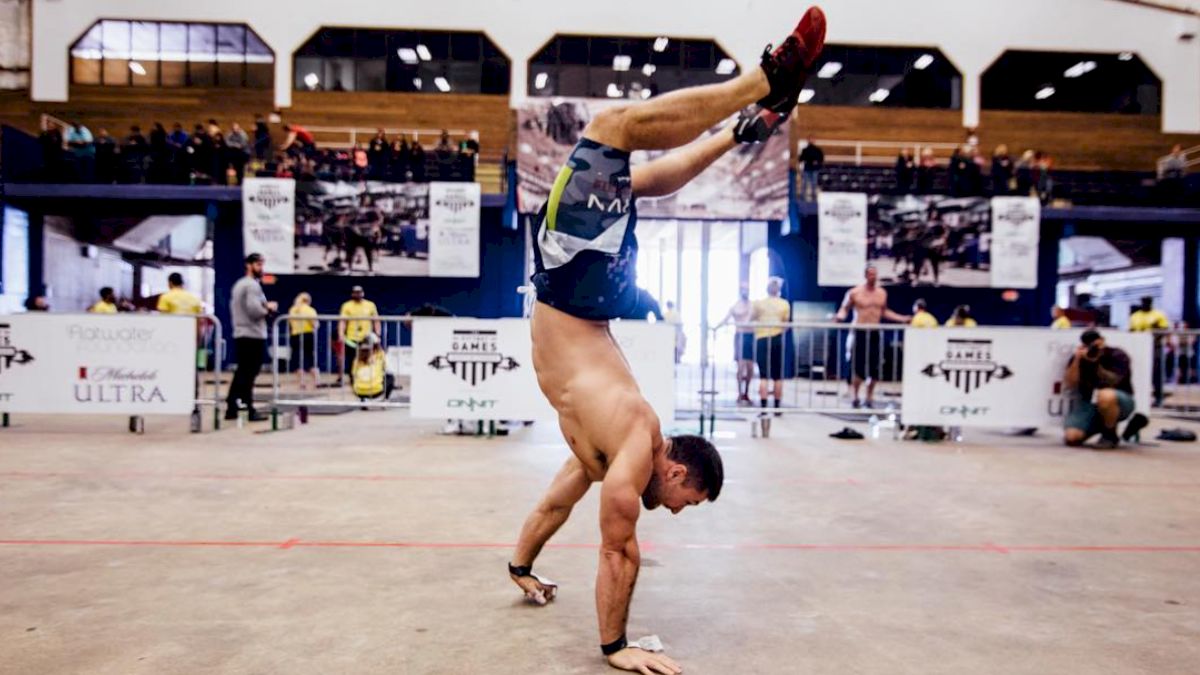CrossFit Games Open 18.4 Strategy By TZ Strength
CrossFit Games Open 18.4 Strategy By TZ Strength
Here is a breakdown of 18.4 including analysis of Scott Panchik's performance, a useful strategy for everyone, and a full warmup.

Okay Dave, seriously? We can have HAND walking but not REGULAR OLD FEET RUNNING? I’m convinced this is personal.
18.4 is for time:
21-15-9 reps of
deadlifts (225/155)
handstand push ups
21-15-9 reps of
deadlifts (315/205)
50' handstand walk
My grief is somewhat allayed by Scott Panchik’s performance. You want to understand how to pace workouts? Watch this on repeat. It was a master class. Let’s learn from it.
Analysis
Reps | Movement | Split | Rep Breaks |
21 | Deadlift 225# | 0:32 | 6, 5, 5, 5 |
21 | Handstand Pushup | 0:39 | 21 |
15 | Deadlift 225# | 0:28 | 5, 5, 5 |
15 | Handstand Pushup | 0:36 | 15 |
9 | Deadlift 225# | 0:17 | 5, 4 |
9 | Handstand Pushup | 0:24 | 9 |
21 | Deadlift 315# | 1:20 | 5, 5, 4, 3, 3, 1 |
50’ | Handstand Walk | 0:24 | 25’, 25’ |
15 | Deadlift 315# | 1:12 | 3, 3, 3, 3, 3 |
50’ | Handstand Walk | 0:29 | 25’, 25’ |
9 | Deadlift 315# | 0:28 | 5, 4 |
50’ | Handstand Walk | 0:20 | 25’, 25’ |
Notes
Split times for each movement are taken when the athlete completes each set. Transitions are therefore accounted for at the beginning of each movement. i.e. the time for the handstand pushups includes the time it takes the athlete to drop the barbell, get to the wall, and kick up.
This is all hand timed and imperfect, but sufficient for our purposes.
This was a thing of beauty. Panchik understood the crux of the workout from the get-go and played his game perfectly. First, he immediately grokked that for high-level (read: aiming for Regionals) athletes, your time on “Diane” does not matter.” He finished at 2:55 – certainly an impressive physical feat objectively, but considering that sub 2:00 “Diane” times are a dime a dozen among elite CrossFitters, it’s quite clear that Panchik wasn’t worried about setting a PR here.*
Further, the handstand walks barely matter so long as you are reasonably competent at them. The heavy deadlifts are so much more fatiguing and time consuming than any other element of the workout that building your strategy around optimizing your performance on the second barbell is indisputably the way to go.
If you’re not among those hallowed few, “Diane” becomes far more relevant. This is because every rep of the heavy deadlift and every rep of the handstand walk becomes far more impactful of your overall placement on the leaderboard. Your pacing strategy, therefore, becomes far more general and places a more equal emphasis on all elements of the event.
*It’s worth noting that the new HSPU standard will be more demanding of shorter limbed athletes like Panchik, so although he was clearly aiming for a smooth and deliberate pace, it’s very possible that his time would have been a bit faster if not for this.
Output Management
Deadlift 225#/155#: Panchik did the deadlifts in four sets, three sets, then two sets. It’s very unlikely you need to do it in fewer sets than he did, even if you’re an elite athlete. If deadlifts are a strength for you, and/or if you are well built for them (long limbed/short torsoed), you maybe want to do three sets, three sets, then two sets. I just can’t see any reason to do fewer than that. Keep your rests quite short – 2-3 seconds to regrip and reset.
If you need to break the deadlifts more than that, your guidelines should be bar speed and cycle rate. If you find yourself having to grind reps out, or having to rest at the top between reps, you’re pushing too hard – drop the bar, shake it out, go again.
Handstand Pushup: Unlike the deadlift, the cost of breaking the handstand pushup is relatively high, since you have to come off the wall to rest. If you’re looking to post a Regionals level score, going unbroken is likely the best option. Unbroken, however, doesn’t necessarily mean fast. Particularly with the new standard, you want to move at a smooth, deliberate pace. If you do need to break, it is absolutely crucial that you do so well before failure. When you fail a handstand pushup, the muscle groups that are breaking down are small, and once they go, they’re gone. You should have a good idea ahead of time of how many sets you’ll need for each round, striving to leave 2-3 reps in the tank each time at minimum.
The pacing strategy for lower level athletes is more or less the same, you’re just going to have to break each round into more sets. The most important thing is staying well clear of failure and minimizing accumulative fatigue in the triceps and shoulders.
Deadlift 315#/205#: Panchik performed the first round in six sets, the second in five, and the third in two. Exceptionally strong deadlifters, with the benefit of having seen Panchik and BKG’s performances, will probably do something like four sets, four sets, two sets or unbroken. The key is to avoid getting to the point where you are forced to singles. A few reasonable rep breakdowns for the first round are 6-5-5-5 (for the strongest pullers amongst us), 5-5-5-4-2, or 3-3-3-3-3-3-3. Aim to perform the second round in 1-2 fewer sets than the first, and the third in 1-2 fewer than the second. If deadlifts are not particularly strong for you, consider beginning each round with a single, to get a feel for a the weight and find your rhythm.
What if you’re not at that level, and these deadlifts are uncomfortably close to strength-work heavy? One effective approach is to treat them like on-the-clock strength work. Pick a number of reps/set and a time interval you think you can stay on top of, and stick to it. For example, 2 reps on 0:20 or 0:30. I do recommend that you try to do at least sets of 2, as typically the second rep of a set of deadlifts is considerably easier than the first, particularly if it’s touch-and-go. If you need to do singles, that’s fine – take the same approach, picking a rep interval and holding it to the best of your ability.
Handstand Walk: Perhaps more than any movement in the history of the Open, this handstand walk either matters A WHOLE LOT or not at all. If you’re proficient at handstand walks, I’ll keep it simple: go unbroken, coming down for a short break at 25’ rather than turning on your hands (unless you’re a former gymnast and your HS walking is just absurd, in which case you don’t need my advice anyway.)
Now, what if the handstand walk DOES matter? Fortunately, it is broken up into convenient 5’ increments. If you know you aren’t performing 25’ walks, follow one simple rule: break your set one full increment before the increment in which you think you are likely to fail. This may seem quite conservative. But given the shortness of the increments, I think this approach is a good one. It makes it highly unlikely that you will fail and it allows you to allay fatigue and keep your rests nice and short (on the clock, not in your head, of course).
If handstand walking is a very weak point for you, but you want to go RX’d, you should shoot for the “falling forward” strategy of performing one increment at a time with short breaks. Trust me, you can get there – I’m basically the shortest person on the planet and 5’ is shorter than me. You got this.
Technical Considerations
Deadlift 225#/155#: Biggest factor here will be saving your low back for the heavier deadlifts. If this were “Diane” on it’s own, I would generally advocate a stiff-legged deadlift style, utilizing more hamstring and low back and very little quadricep, allowing for less movement at the bottom and a faster cycle rate. If you are at a very high level, this is probably still the right way to go. If, however, you expect the heavier deadlifts to be particularly challenging, it’s probably worth performing a more traditional deadlift, flexing the knees at the bottom and using your quads to initiate the lift.
Handstand Pushup: KIP YOUR FACE OFF. Don’t cut your kip short for the sake of speed. Make sure to get your knees deep and get a big leg drive – save those triceps and shoulders!
Deadlift 315#/205#: Almost everyone should be doing “real” deadlifts here, i.e. setting up the lift in such a way as to get strong leg drive off the floor. If you have a six-hundred pound deadlift, you can do what you want.
Handstand Walk: Not a heck of a lot to say here – there’s nothing about this workout that requires any modification to basically correct handstand walking technique. Try not to fall too much, and if you do, definitely don’t kick your judge in the head.
Other Notes
Footwear: Socks are your friend! There’s nothing here that requires wearing shoes (personally I feel much stronger deadlifting without them), and unless your walls are particularly splintery, socks will allow your feet to slide along much more easily during HSPU. Be sure that you take your HSPU measurement without your shoes on if you want to do this!
Set-Up: If you’re lucky enough to be able to set up two barbells, do it! If not, try to have someone load your barbell from 225#/155# up to 315#/205# while you’re on the final sets of HSPUs in “Diane.” If you’ve got to load it yourself, don’t rush. Breathe, move smoothly, and use the rest to your advantage.
As Always: Read the standards. Read them again. Watch the videos. If it’s relevant for you, make sure you fully understand the filming standards and make sure that you have a time established at your gym where you can expect to perform the workout uninterrupted. Don’t force yourself into an unnecessary redo because you didn’t do your homework.
Warm Up
Note: This is only the part of the warm-up which is specific to the Open workout. It should not replace your general warm-up routine.
Row 1000m + 30 Russian Kettlebell Swings (light) + 15 American Kettlebell Swings (light)
3 Rounds:
10 Split Stance Romanian Deadlift, left leg, light and controlled
10 Split Stance Romanian Deadlift, right leg, light and controlled
0:15-0:20 Chest-to-Wall Handstand + 0:05-0:10 Handstand Negative
EMOM 10, alternating:
Deadlift 10-2 (Start at 10, subtracting two reps per set and adding weight. Weights: 135#/95#x10, 185#/125#, 225#/155#, 275#/185#, 315#/205#).
2-4 Handstand Pushups + 10’ Handstand Walk

About The Author: Jacob Tsypkin is the owner of TZ Strength. He began CrossFit in 2005, owned a gym for seven years, and switched to programming and remote coaching full time in 2014, after realizing he was just truly bad at mopping floors. In his free time, Jacob can be found battling fellow wizards at Magic: The Gathering, pontificating at the intersection of epistemology, ethics, sport, and training on his blog Exercise Philosophy, or singing Sea Shanties at the Harbor, waiting for his frenemy Armen to sail in on the tide.